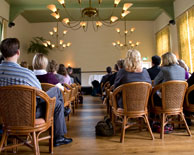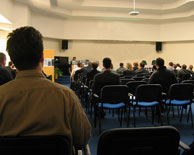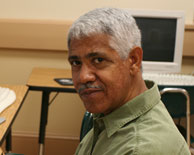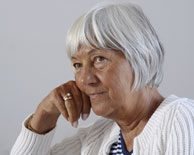Healthy Brains
Overview of Current Research
The Old Paradigm
- You are born with a finite number of brain cells with fixed pathways and you can’t grow your brain at a cellular level.
- Potential prevention and cures for diseases like dementia and Alzheimer’s will come someday from a therapeutic medical breakthrough.
The New Paradigm
- We all still hope for the medical solution, but in the meantime…
- Mounting evidence suggests we can have an impact on the probability of getting these diseases by how we use our brain today.
Research strongly suggests that regular intellectually stimulating activity can slow cognitive decline and reduce the likelihood of dementia and/or Alzheimer’s Disease.
Cognitive activity may be protective. We are building and strengthening neural pathways so they are less susceptible to disease.
Intellectually stimulating activities (key is NEWNESS)
- Attending lectures
- Doing crossword puzzles
- Participating in discussion groups
- Reading the newspaper
- Playing a musical instrument
Research Highlights
- A one-point increase in the cognitive-activity score, which corresponds to participation in an activity for one day per week, was associated with a reduction of 7 percent in the risk of dementia.
- Subjects who engaged in cognitive activities four times a week had a 47% lower risk of dementia than those at once a week.
- The relative risk of developing Alzheimer’s decreased by 33% for each one-point increase in cognitive activity.
- A one-point increase was also associated with reduced decline in global cognition of 47%, working memory 60% and perceptual speed 30%.
- A person whose cognitive activity was in the top 10% of the group, had a 47% lower likelihood of developing Alzheimer’s.
Many other researchers have reached similar conclusions
“Those who treat memory loss and other maladies of the elderly have long been intrigued by evidence that an active mind might ‘vaccinate’ the brain against Alzheimer’s disease and other chronic neural disorders that may appear over time. Researchers know that animal brains readily respond to stimulating enriched surroundings by developing more intricate connections between brain cells. Until now, however, no one knew what brain mechanisms might be involved in the aging human brain.” [LA Times, 3/14/05]
“That which is new is difficult. That is precisely what challenges a part of the brain, an old part called the reticular formation, and it responds to newness, and it stimulates not only brain activity, but brain growth. And that’s what we’re trying to achieve for the older person.” [Neuroscientist Dr. Arthur Schiebel, UCLA]’
“Once it was believed that all of the brain’s neuronal circuits were hard-wired, like the telephone system, with fixed circuits that could never be changed. But in fact we have learned that neurons are amazingly adaptable. ‘We now know that there are multiple levels where neurons adapt. And they engage in these plasticity mechanisms short term, so that they can change the strength of the connections. In the long term they can actually regrow new synapses, reforming in place of the old ones by a thing called sprouting…[I]t’ll actually grow back again with proper stimulation….What most researchers had intuited is now pretty well supported by research. ‘Stimulation, novelty is great for an aging brain, great in terms of function, great in terms of neurons actually growing new processes, things of that sort. Great. Go get stimulated.” [Dr. Carl Cotman, professor of psychobiology and neurology at the University of California, Irvine and Robert Sapolsky, Assistant Professor of biology and neuroscience at Stanford University]
Additional Resources
- The Healthy Brain Program www.healthybrain.org
- Alzheimer’s Association www.alz.org
- Alzheimer's Disease Education & Referral Center www.alz.org
- Society for Neuroscience www.sfn.org
- The Nun Study www.nunstudy.org
- Fast ForWord software and information www.scilearn.com
- The Arrowsmith School in Toronto www.arrowsmithschool.org
- The Taub Therapy Clinic www.taubtherapy.com
- Zane Robertson article: Lifelong Learning & The Aging Brain
- Zane Robertson talk: Lifelong Learning & The Aging Brain (slides)
- Journal of the American Medical Association, February 13, 2002
- New England Journal of Medicine, June 19, 2003
- Journal of the American Medical Association, December 20, 2006
Books For Further Reading
- Begley, Sharon. Train Your Mind, Change Your Brain: How a New Science Reveals Our Extraordinary Potential to Transform Ourselves. Ballantine Books, 2007. 304 pages.
Description: Is it really possible to change the structure and function of the brain, and in so doing alter how we think and feel? The answer is a resounding yes. In this fascinating and far-reaching book, Wall Street Journal science writer Sharon Begley reports on how cutting-edge science and the ancient wisdom of Buddhism have come together bring about a revolution in our understanding of the human mind.
Click here to order - Doidge, Norman, M.D. The Brain That Changes Itself. Viking Books, 2007. 427 pages.
Description: An astonishing new science called neuroplasticity is overthrowing the centuries-old notion that the human brain is immutable. Psychiatrist and psychoanalyst, Norman Doidge, M.D., traveled the country to meet both the brilliant scientists championing neuroplasticity and the people whose lives they've transformed--people whose mental limitations or brain damage were seen as unalterable. Dr. Doidge has written an immensely moving, inspiring book that will permanently alter the way we look at our brains, human nature, and human potential.
Click here to order - Jill Bolte Taylor, Ph.D. My Stroke of Insight. Plume Books, 2009. 206 pages.
Description: The astonishing "New York Times" bestseller that chronicles how a brain scientistas own stroke led to enlightenment. On the morning of December 10, 1996, Jill Bolte Taylor, a thirty-seven-year-old Harvard-trained brain scientist, experienced a massive stroke when a blood vessel exploded in the left side of her brain. A neuroanatomist by profession, she observed her own mind completely deteriorate to the point that she could not walk, talk, read, write, or recall any of her life, all within the space of four brief hours. As the damaged left side of her brain swung in and out of function, Taylor alternated between two distinct and opposite realties: the euphoric nirvana of the intuitive and kinesthetic right brain, in which she felt a sense of complete well-being and peace; and the logical, sequential left brain, which recognized Jill was having a stroke, and enabled her to seek help before she was lost completely. Taylor shares her unique perspective on the brain and its capacity for recovery, and the sense of omniscient understanding she gained from this unusual and inspiring voyage out of the abyss of a wounded brain.
Click here to order






Sponsored Links
Tattered Cover Book Store
Support your local independent book seller and Active Minds.
www.tatteredcover.com
